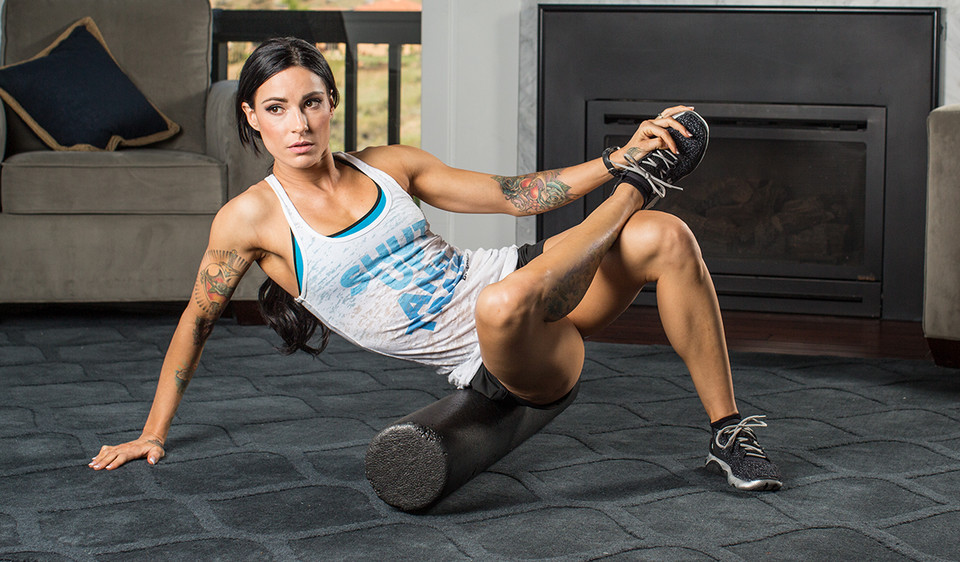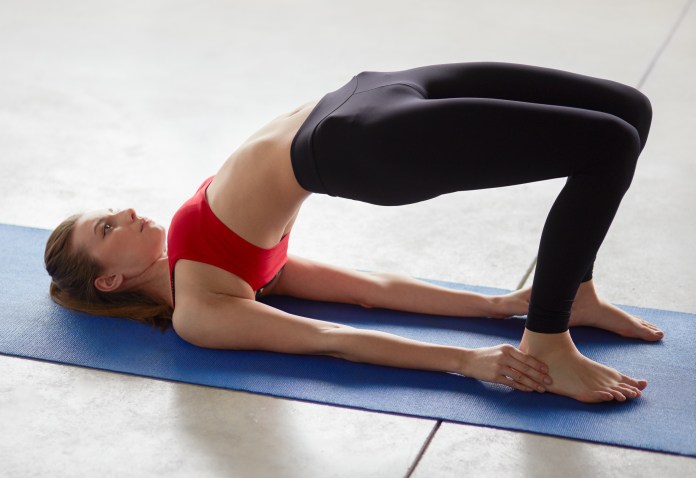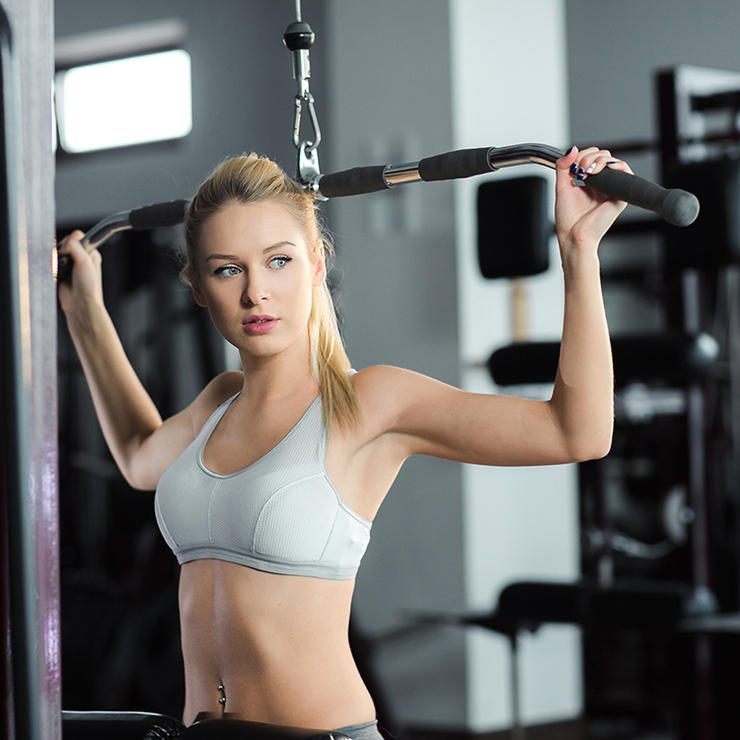You probably already know that strength training and building muscle has a lot of health and other benefits. It helps increase bone density and decrease the risk of osteoporosis. It helps control your weight and helps you look and feel better. But there’s another muscle a hidden one that many women often neglect to strengthen. Exercising this one isn’t about fending off osteoporosis or having Michelle Obama’s sinewy, toned arms.
This one is about working a muscle you can’t see. And sometimes out of sight equals out of mind thus the neglect. You can’t see your pelvic floor muscles, but they play a really important role in your health. They’re the muscles that support your pelvic organs: your uterus, bladder and rectum.
By now, you’ve probably figured out that men’s and women’s bodies don’t work quite the same way.
Get your mind out of the gutter. We’re talking about the weight room, here. Men and women have huge differences in their body compositions, joint alignments and connective tissues, all of which affect their muscle strengths, weaknesses, and susceptibility to injury, says exercise physiologist and trainer Marta Montenegro, MS, CSCS.
Here’s the deal, ladies: If you aren’t giving these areas some extra TLC, chances are they are majorly weak. “When the muscles aren’t at the ‘same level’ in terms of strength and flexibility, it both reduces the efficiency of every movement and increases risk of injury to muscles, bones, tendons and ligaments,” Montenegro says. “If something on this chain is off, something [else] will pay the price.”
What’s going on down there?
The obvious joys of childbirth and the dubious joys of aging … can you guess the connection? A weakening in the pelvic floor muscles.
These are changes that other people can’t see. Only you (and possibly your gynecologist and your partner) know about.

A quick anatomy lesson: Your pelvic floor muscles are made up of ligaments, connective tissues and nerves. They work like a hammock or sling to support your pelvic organs. These muscles stretch from your pubic bone (at the front) to the base of your spine (at the back) and give you control when you urinate, defecate or pass gas.
Blame childbirth, hysterectomy, obesity or menopause for this unwanted slackness. The risk increases with multiple pregnancies and vaginal deliveries, especially if you’ve had an episiotomy or suffered vaginal tears.
The wrath of weakness
- Urinary incontinence
- Fecal incontinence
- Pelvic organ prolapse (The uterus, bladder and bowel “drop” onto the vagina and bulge through the vaginal canal kind of like a hernia.)
- Reduced sensitivity during sex
I’d say this could greatly impact a woman’s quality of life. Yes, hardly a pretty picture.
Why the hush-hush?
Many women and medical professionals are hesitant or embarrassed to talk about this health issue, although the problem is very common. It’s estimated that more than one-third of women in the United States are afflicted with a pelvic floor disorder (PFD), and about 377,000 had surgery in 2010, with that number expected to significantly increase over the next several decades.
PFD can be easily diagnosed with a physical exam. Sometimes, during a routine pelvic exam, your health care provider will spot or feel a telltale bulge that suggests prolapse. Or, you may already be reporting symptoms like trouble with bladder or bowel control.
There are other more sophisticated tests that can follow an initial physical exam, too.
What you can do
Kegel exercises are the only prevention, but most women don’t know how to properly do these, says women’s health expert and advocate Donnica L. Moore, MD. In addition, the exercises are not always effective, especially once the problem is more advanced.
I’m betting you know about Kegels. But I’m also betting that, like so many of us, you forget to do them regularly, if at all. It’s one of those things that are just not often top-of-mind. Some women (if they remember) sneak them in while waiting in line, at a red light or while trying to fall asleep. But the key is to remember to do them and hopefully, they’ll become a permanent part of your daily routine.
A how-to from the Mayo Clinic

To get started:
1.Find the right muscles.
To identify your pelvic floor muscles, stop urination in midstream. If you succeed, you’ve got the right muscles. Once you’ve identified your pelvic floor muscles you can do the exercises in any position, although you might find it easiest to do them lying down at first.
2.Perfect your technique.
Tighten your pelvic floor muscles, hold the contraction for five seconds, and then relax for five seconds. Try it four or five times in a row. Work up to keeping the muscles contracted for 10 seconds at a time, relaxing for 10 seconds between contractions.
3.Maintain your focus.
For best results, focus on tightening only your pelvic floor muscles. Be careful not to flex the muscles in your abdomen, thighs or buttocks. Avoid holding your breath. Instead, breathe freely during the exercises.
4.Repeat three times a day.
Aim for at least three sets of 10 repetitions a day.
It’s best not to practice your Kegels when you urinate, by starting and stopping its stream; the danger is that it can actually make you retain urine, leading to the risk of a urinary tract infection.
Strength Training for Women: 3 Neglected Muscle Groups
1. Your Chest
One of the most common weight room stereotypes: That pecs are a “guy thing.” Women naturally have a smaller ratio of muscle-to-fat in their chests compared with men. Unfortunately, this means that many women get frustrated with chest-strengthening exercises and either forgo them entirely or do them with improper form, according to Montenegro.
Think about it: How many times have you collapsed mid push-up and thought, “I’m strong! Why can’t I do this?” It’s because most women actually have to train in order to do what, for men, may seem easy.
Strengthen It:-
The Eccentric Bench Press and Push-Up
To master this move, prepare to slow down and put the emphasis on the eccentric (downward) motion rather than the press upwards. (You can even have someone else raise the barbell for you.) This actually works your chest more intensely than a standard bench press, since your muscles get stronger moving eccentrically than concentrically. Plus, it trains your underlying core muscles (more on that later), and your triceps, which are naturally small and tend to tucker out even before your larger chest muscles do.
How to:-
Lay flat on a bench, holding a barbell just above your chest, elbows positioned near the sides of your body. Your palms should be facing up, hands chest-width apart. Press the barbell directly upwards until arms are fully extended (or have a spotter help you lift it), and then slowly lower it back down to your chest for a count of four to five seconds. Perform three to four sets of eight to 10 reps each week.
For a bodyweight-only option, push-ups are another complex movement that will hit the chest muscles (in addition to the shoulders, arms and core). Complete the standard variation, or try incline (hands elevated) and decline (feet elevated), Montenegro suggests. That will help you train multiple areas within your pectoralis muscles. Once a week, complete three to four sets of as many reps as you can manage with proper form.
2. Your Hamstrings
Many women are all about leg extensions, squats, lunges and, of course, spinning when they work out. And while those routines can all help strengthen your lower body, they emphasize the quadriceps more than they do the hammies, Montenegro says. “Women’s quadriceps actually tend to be about twice as strong as their hamstrings,” she says. Add in high heels and things can get more uneven. Wearing pumps transfers your body weight forward, so your quadriceps work harder with every step.
This imbalance can make women vulnerable to knee injuries especially because their knees are already under a lot of pressure. What’s more: women’s pelvises are naturally wider than men’s, meaning that the femur, which attaches to the pelvis and knee, doesn’t go straight up-and-down. Instead, it slants so that body forms an “X” shape, she explains. Add that to the fact that monthly spikes in your estrogen levels can make joints more flexible, and there’s no option left but to strengthen your hammies in order to protect your knees.
Strengthen It:-
The Dumbbell Single-Leg Deadlift
“One of the best exercise to work the hamstrings is the dumbbell single-leg deadlift,” Montenegro says. As you progress, you can perform barbell deadlifts to further train your hamstrings while also strengthening your lower back and glutes.

How to:-
Stand with feet together, knees slightly bent, holding a dumbbell in the right hand. Keeping your back flat, begin to lean forward, hinging at the hip. Squeeze your left glute and hamstring and extend your right leg straight out behind you for balance. Your right arm will be perpendicular to your right leg. Return to starting position, switch sides. Shoot for three to four sets of eight reps on each side every week.
3. Your Core
Women’s bodies are built to be able to squeeze out a baby, meaning that the ligaments and tendons in your hips are more elastic and loose than those of the average guy, Montenegro says. Plus, ladies have a larger lumbar (low back) curve. So, in order to maintain correct posture, you need a killer core.
Unfortunately, most women don’t have the strong midsection they need. While there may be plenty of “core-sculpting” of the (look at me!) abdominal muscles (often through crunch and crunch variations), these movements don’t give their deep, stabilizing muscles the attention they need, she says. Those internal muscles are what is going to keep you upright and help you power through everything from running to kickboxing.
Strengthen It:-
The Plank (left) and the Bird-Dog (right)
Your core is so important, we’ve got two moves for you to try. Plank it up with side and front variations of the core-strengthening exercise. Or try the bird-dog, which is awesome for your back, Montenegro says.
Plank How-to:-
For the plank, support yourself on your forearms, keeping your shoulders over your elbows, knees up, butt down and back flat. Want to hit all areas of your midsection? Add in the side plank, where you’ll support yourself on one forearm, body angled to the side and knees lifted. With your chest open, raise your other forearm straight above your body. Once per week, complete each plank variation three times, holding the position for 30 seconds and working up to 60.
Bird-Dog How-to:-
To do the bird-dog, start on all fours, back flat. Raise your right arm straight out in front of you, while simultaneously lifting your left leg straight behind you. Repeat on the opposite side. Complete three to four sets of 10 to 12 reps on each side at least once per week.
For more information visit us our website: https://healthcaretipshub.com







No Comment! Be the first one.